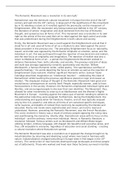'The Romantic Movement was a revolution in its own right.’
Romanticism was the dominant cultural movement in Europe from the end of the 18 th
century and well into the 19th century. A large part of the significance of this movement
lay in its rebellious nature as it revolted against the previously central movement of
Enlightenment. With the movement only being named and defined in the 19 th century,
the liberation of artists’ imagination and style stemmed from the rise of Romantic
thought, and spread across all forms of art. This movement was a revolution in its own
right as the artists of the era used their art to rebel against the rigid control and order
that was predominant during the Enlightenment in both culture and society.
Firstly, the Romantic Movement was a revolt against the Enlightenment and all that it
stood for in art and used all forms of art as a medium to also rebel against the social
ideals prevalent in the previous era. The prevailing Enlightenment focus on rationality,
reason, and order was opposed by the Romantic emphasis on emotion, sense, and the
individual. In art, this was portrayed through the rejection of neoclassicism and realism,
and the new focus on originality and imagination. The rejection of realism was also a
return to Medieval forms of art – a period the Enlightenment Movement wished to
distance themselves from, both culturally, and socially. The previous restraint of ideas
and style was strongly opposed by romantic spontaneity and intuition. William
Wordsworth, a famous Romantic writer, called poetry, “the spontaneous overflow of
powerful feelings,” his words depicting the focus on emotion as well as the rejection of
Enlightenment-style restraint. Another significant Romantic writer, Samuel Taylor
Coleridge described imagination as “intellectual intuition” – celebrating this ideal of
Romanticism whilst taunting the previous significance placed on logic and reason as
intellect. This displayed change of thought in the Romantic Movement held great and
revolutionary consequences on society itself. People, especially women, used to have
fixed positions in the society. However, the Romantics emphasized individual rights and
liberties, and encouraged people to discover their own identities. The Movement, thus,
allowed for other movements to arise such as Abolitionism and the Women’s Rights
Movement in Europe – revolting against the status-quo of women needing to adhere to
the patriarchal roles they were assigned. Furthermore, during the Enlightenment, the
understanding and appreciation for literature, theatre, and art was typically enjoyed
only by the rich, powerful, and elite as all forms of art contained specific techniques,
niche nuances, and depths of context that could only be explored by the literate and
educated. Poetry and novels were sophisticated and clever, yet hard to read and
understand. However, preceding the Romantic Movement, was the French Revolution.
This iconic moment in history was a result of ordinary people opposing the ruling class
and overthrowing the monarchy. Shortly after, Romanticism arose with its focus on the
individual – and the ordinary, every-man individual. Hence, in Romantic literature, a
revolution followed. Famous writers such as Wordsworth and William Blake began
utilizing simpler, ordinary language, still shaped into beautiful and evocative prose, and
thus, still enjoyable to everyone, regardless of education and social standing – creating
a cultural revolution where Romanticism spread.
The Romantic Movement was also a revolution as it opposed the change brought on by
industrialization by returning and idealizing a past where man lived in harmony with
nature. Industrialization changed everything in Europe when it first began in the 19 th
century. The construction of new factories destroyed large landscapes and drove people
out of settlements. Those who worked and lived near these factories survived in terribly




